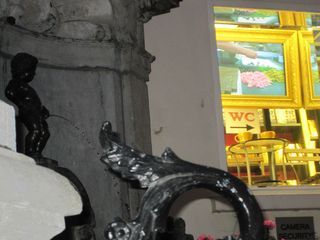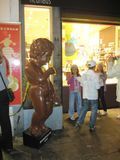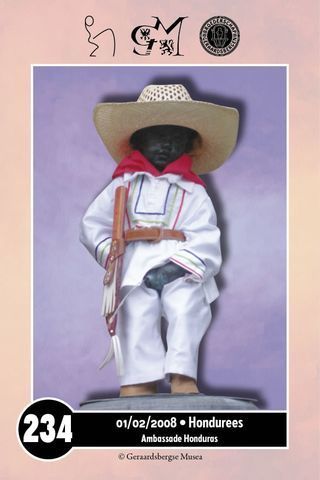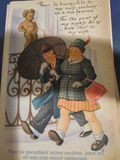Why does the Manneken Pis?

The icon of Brussels is (to judge from the souvenir shops at least) the bronze fountain/statue of the little boy pissing, the Manneken Pis. It is an image that, in Brussels, goes back to the seventeenth century; but the idea of a fountain spouting water as if it was peeing goes back at least to the Romans, and probably  before. It's not a hugely imaginative idea.
before. It's not a hugely imaginative idea.
Anyway, you can now buy battalions of this little guy, most made I guess in China (a few blazon "Made in Belgium", but most are not homegrown -- has anyone ever  gone to one of these Chinese factories where miniature images of the great monuments of the West are churned out?). And if you dont fancy a key ring, you can buy him in chocolate, or see him in a more than life size pretend-chocolate model. Every tour group is brought to admire.
gone to one of these Chinese factories where miniature images of the great monuments of the West are churned out?). And if you dont fancy a key ring, you can buy him in chocolate, or see him in a more than life size pretend-chocolate model. Every tour group is brought to admire.
 My question was: why has THIS become the icon of Belgium? Most cities have a much more visible symbol (Big Ben, the Parthenon, the Eiffel Tower), but this little boy is barely a metre tall and in what would have been a back street, if it hadnt been for him. He is supposed to go back to the early seventeenth century (stolen and broken up in the nineteenth, and remade from a mould of the pieces), and there are all kinds of urban legends about what he might stand for. The one I was told years ago was that he was a lost rich child, whose father vowed a statue of him doing whatever he was doing if and when he was found. But there are plenty of others. I rather like the ideas that it reminds us of the brave kids of Brussels who ensured their city's victory by pissing on the enemy from trees.
My question was: why has THIS become the icon of Belgium? Most cities have a much more visible symbol (Big Ben, the Parthenon, the Eiffel Tower), but this little boy is barely a metre tall and in what would have been a back street, if it hadnt been for him. He is supposed to go back to the early seventeenth century (stolen and broken up in the nineteenth, and remade from a mould of the pieces), and there are all kinds of urban legends about what he might stand for. The one I was told years ago was that he was a lost rich child, whose father vowed a statue of him doing whatever he was doing if and when he was found. But there are plenty of others. I rather like the ideas that it reminds us of the brave kids of Brussels who ensured their city's victory by pissing on the enemy from trees.
What I hadnt realised till we went last week was that he also had a wardrobe.

Kept in the Musée de la Ville de Bruxelles are the many and varied costumes he has been presented with by local and visting delegations. Where these are made, heaven knows.. but I have never seen the little chap dressed up.
Anyway, we couldnt resist going to see his kit when we were there last weekend. And as we going out of  the Museum we couldn't help notice some packs of what looked like repro 1950s postcards. These confirmed the sense of wonder -- because they foregrounded the sexuality of the image that most modern renderings would ostensibly disavow. OK they were sexualised only at one remove, but sexualised nevertheless. The repeated joke (as you can see; and it came in various forms) was the one about the middle-aged lady who sees the statue of the little boy, and suddenly gets horny.. to the distress of her middle-aged husband who sees that he is in for an energetic
the Museum we couldn't help notice some packs of what looked like repro 1950s postcards. These confirmed the sense of wonder -- because they foregrounded the sexuality of the image that most modern renderings would ostensibly disavow. OK they were sexualised only at one remove, but sexualised nevertheless. The repeated joke (as you can see; and it came in various forms) was the one about the middle-aged lady who sees the statue of the little boy, and suddenly gets horny.. to the distress of her middle-aged husband who sees that he is in for an energetic  night.
night.
You coudn't sell these now. Or could you? And in what form? We imagined that we were buying repros of historic souvenirs. But getting them out on the train back home, they looked more like the real thing. There was nothing printed on the back about what they were copying, and the edges were decidedly yellow. Were they actually still flogging old stock?
And still no-one had quite explained why this pissing toddler was the icon of the city. Is it really just, as the guide books would claim, an encapsulation of the 'irreverent spirit" of Brussels.. a kind of Tin Tin avant la lettre?
Mary Beard's Blog
- Mary Beard's profile
- 4070 followers



